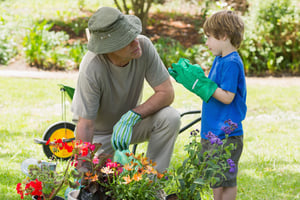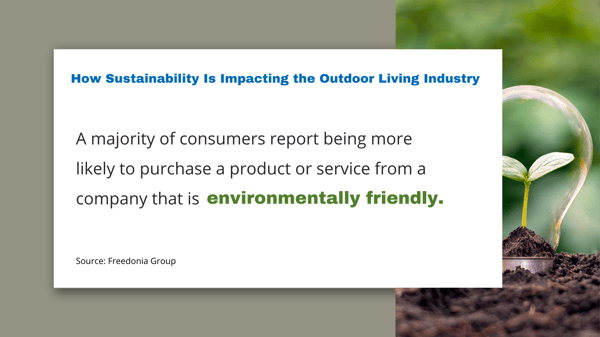 Sustainability is key trend impacting the outdoor living market, which encompasses a variety of applications such as:
Sustainability is key trend impacting the outdoor living market, which encompasses a variety of applications such as:
- Lawn and yard maintenance
- Outdoor cooking, entertaining, and recreation
- Outdoor design and landscape materials
- Gardening
In a recent video, The Freedonia Group’s Industry Studies Manager Jennifer Mapes Christ sat down with Research Analyst Peter Kusnic to discuss why sustainability is such an important trend to watch in the outdoor living industry and how companies are working to address sustainability concerns.
Watch the video to hear their discussion or read a transcript of the Q&A below.
Why is sustainability particularly important in the outdoor living market?
For one thing, it can be a differentiating factor for suppliers. We tend to find that people who are interested in gardening and enjoying the outdoors are generally more concerned about their environmental impact of how they live, so they are looking for something that has a green element to it. How can you enjoy your outdoors if you are not also taking care of your outdoors? That’s often a way that people are thinking about it.
What makes a sustainable outdoor living product? What type of products are sustainability-minded consumers going for most?
It really depends on the category. For instance, emissions reduction is one element and might include electric power tools and electric power equipment over gasoline-powered engine-driven models.
Reduced energy usage is another element. Examples could include solar-powered outdoor lighting.
For gardeners, it often means organic gardening products or elements that limit or eliminate the use of pesticides.
Another element could be the packaging that’s used for these products. A lot of customers tend to be less aware of that when they are deciding and choosing their product at this point, but they are definitely thinking about it as they are getting rid of the packaging after they are done with it.
Examples could include making sure there is no excess packaging and that the packaging that’s being used to wrap the product is recyclable or even compostable, which is something that really appeals to a lot of gardeners.
How are outdoor living suppliers working to address consumer’s sustainability concerns?

One of the big areas where there is a lot of innovation happening is the batter-powered section. They are looking to create versions that have longer run time and have greater power, and that makes these products more useful, beyond a casual, small-yard weekend user and makes them more appropriate and useful for professional landscapers. If it lasts longer, runs longer, and has the power they need to get the job done, it opens it up to a larger customer group.
Another one is they are working on making their packaging more circular. You see that a lot in bags of fertilizer or packaging of soil and things like that. Can it be recycled or composted? Is the packaging lighter weight? Is it just enough to protect the product and reduce waste?
Another element is developing more consumer education, so that the expectation of how more sustainable products are going to work aligns with the sort of performance they can expect. For instance, not expecting a more sustainable pest-control effort to be instant, but instead part of a more wholistic process.
Where to Learn More
To learn how sustainability is impacting other key industries, check out our recent blog post "5 Industries Benefiting from Going Green."
To stay on top of new industry research in the fields of your choice, subscribe to monthly Industry Update Emails from MarketResearch.com. Use this link or the button below to sign up for free.
About the Author: Sarah Schmidt is a Managing Editor at MarketResearch.com, a leading provider of global market intelligence products and service


